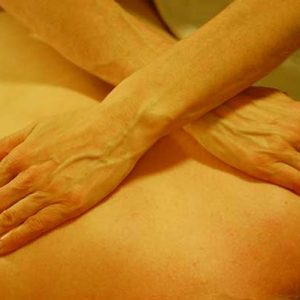
In all cultures of the world, and during all eras, touch has symbolized the highest aspiration to love, community and peaceful harmony.
One hand clasping another is a universal symbol for friendship and cooperation. The loving embrace of husband and wife or parent and child represents our fondest wishes for ourselves and others. When we meet a fellow, whether lover, friend or business associate, we usually expect to touch or be touched. When we are moved, we say we have been touched by our experience. If we speak of being held in the hand of God, we are saying that we are cared for and at rest, and that Infinite Mercy and Compassion are contained in that Touch.
Healing is a metaphor for spiritual awakening. The healer is meant to bring into movement the most powerful resources we have for restoration and renewal. Touch is one of the most fluid media for this restoration of body and soul. The Rhythmical Massage therapist awakens and strengthens powerful life forces, which open the patient to the unfolding of health and well-being.
That our spiritual state is represented by the appearance and carriage of our bodies is well understood by artists and healers. The dancer, who leaps, arms outstretched, tells us a story we do not have to puzzle over. The actor who portrays suffering, fist clenched and body curved downward, speaks to us in the moment of our perception. Rhythmical Massage addresses chronic syndromes and severe traumas by invigorating the deep rhythms of the body that are the essential expression of life.
In the 1920’s Dr. Ita Wegman, a physician schooled in physiotherapy and massage, established a clinic in Switzerland where anthroposophical medicine was first practiced. There she developed rhythmical massage therapy by applying a spiritual understanding of the human being to Swedish Massage. Later Dr. Margarethe Hauschka joined the clinic and collaborated with Dr. Wegman to further develop this new approach. Dr. Hauschka named the new method of healing `Rhythmical Massage’ as indicated by Dr. Ita Wegman, thereby identifying both its basic nature and the name of the founder.
When we think of massage we often think of pressure, kneading, or breaking down muscular tension. While gentle, penetrating pressure is part of rhythmical massage treatment, its counterpart, a `drawing out touch,’ is also fundamental. The metaphors we have been using, in particular the feeling of a spiritual force rising from within the patient, are the best context for understanding this stirring of the subtlest parts of our bodies. We intuitively incorporate this principle when we speak of “love rising from our hearts,” or “spirit rising to the light.”
Fortunately for all of us, this therapy has continued to be studied and taught since the pioneering work of its founders. In 1963, Dr. Hauschka opened the first school for Rhythmical Massage in Germany. Since then, schools have been founded in Holland, Australia, Brazil and South Africa. The first North American school was founded in 1993, and continues to train therapists with comprehensive courses that immerse the student in practical massage techniques along with artistic activities in complementary therapies such as eurythmy, painting, and singing. In addition, lectures on pathology, spiritual anatomy, and physiology are provided by practicing anthroposophical physicians.
There is not just one rhythm in life, but many interconnected rhythms belonging to each of us in all our parts: body, mind, and emotions. This essential balancing of our subtlest energies is the work of Rhythmical Massage. In the words of Rudolf Steiner, “Study rhythm; rhythm is the bearer of life.”
by Ed Humpal
Ed Humpal is the Plant Manager of the Kimberton Waldorf School and the Board Secretary of The School for Rhythmical Massage. Information on Rhythmical Massage training can be obtained by visiting the school’s website, www.rhythmicalmassage.org
